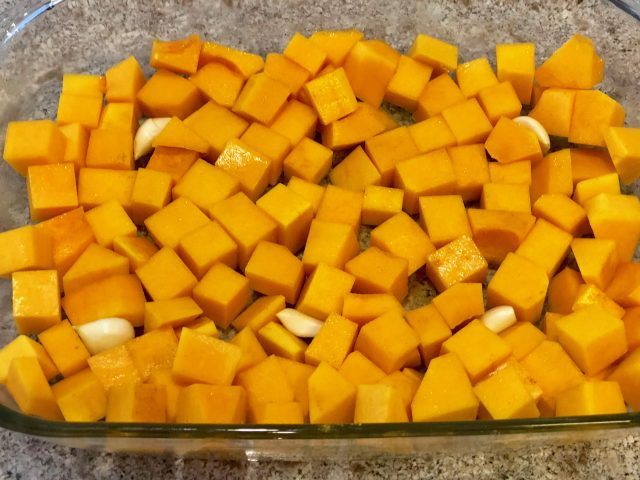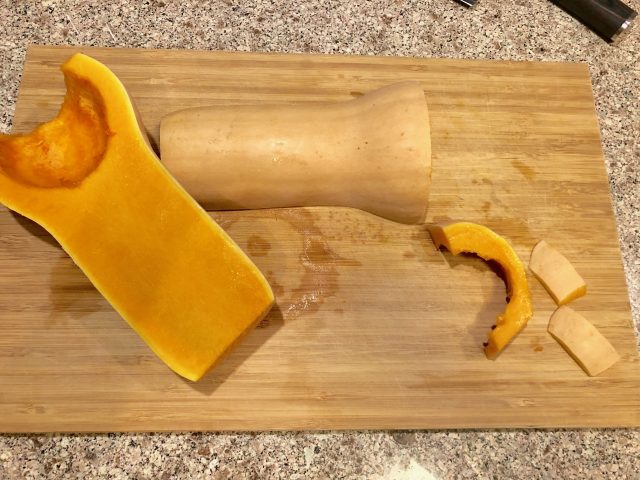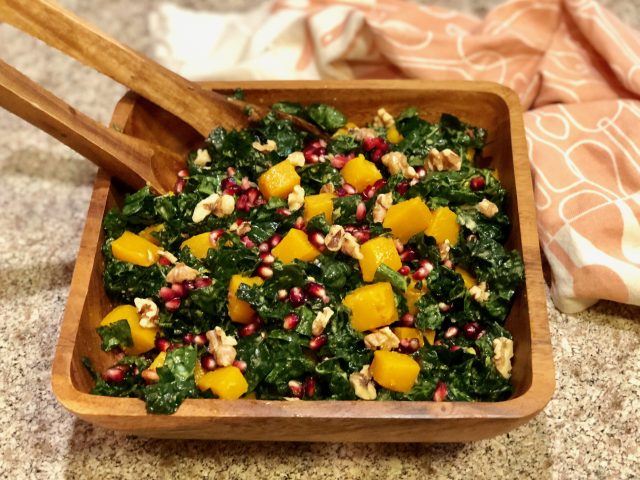This colorful, nutrient-rich salad is savory but slightly sweet and is one of my favorite additions to a Thanksgiving meal. The crunch from the walnuts and pomegranates provides a nice contrast to the soft roasted butternut squash, and the flavors are all brought together with a bright lemon maple vinaigrette. Even if you are a lover of traditional Thanksgiving dishes (I am too), you can still enjoy all the classics while adding this vegetable-forward, lighter addition to the spread.
If you’re having a small Thanksgiving meal and are looking to limit your total dishes, this fall salad can stand alone as a side that is packed full of cancer-protective vegetables, nutrient-dense starches, and heart healthy fats.
Seasonal fall vegetables – like butternut squash – are rich and comforting when the weather starts to cool down, while also packing in a hearty dose of nutrients. This salad features three of AICR’s Foods that Fight Cancer – winter squash, cruciferous vegetables (kale), and walnuts. Winter squash are rich in the carotenoids beta-carotene and alpha-carotene, which act as antioxidants in the body. Kale also contributes plenty of carotenoids, and walnuts contain healthy antioxidants vitamin E, omega-3 fatty acids, and melatonin. Together, these ingredients provide a mega dose of cancer-fighting compounds.
Prep Ahead
There are several things you can prepare ahead of time to make your Thanksgiving-day cooking quick and easy. The day before, roast the butternut squash and garlic, make your dressing, and thinly slice your kale. Store all in separate airtight containers in the refrigerator. Take the squash out of the fridge at least 45 minutes before serving to allow it to come to room temperature.

You can also speed things up even more by buying cubed butternut squash and pomegranate seeds (vs. the whole fruit). However, you will save a money by buying the whole squash and pomegranate.
If you are using a whole squash, it can be a bit tricky to cut. Make sure to cut the edges first and always set down the flat side of the squash before making a slice. Cut the squash in half lengthwise, scoop out the seeds, and set each half flat-side down on a cutting board. Cut the squash into 1-inch thick slices. Individually lay each slice flat and cut the skin off in several slices around the edges (squash skin is too tough for a regular vegetable peeler).

Seeding a pomegranate can also be a bit messy. Slice the fruit in half and hit the skin-side of each half with the back of a sturdy spoon over a bowl of cold water. The pomegranate seeds will start to fall out and sink to the bottom of the water, while the white pith will float to the top. Once you’ve extracted all the seeds you can drain off the pith and keep the remaining fruit.
With the majority of your ingredients prepped ahead of time, Thanksgiving Day will be a breeze. Squeeze lemon and a pinch of salt over your kale and gently massage it with your hands to soften the leaves. Add the remaining ingredients (minus the walnuts) and drizzle with the maple vinaigrette. Toss the salad well and finally, serve it topped off with walnuts.
You can also make variations on this dish with a little added Parmesan or goat cheese. Pumpkin seeds (pepitas) or pecans are also a nice alternative to walnuts. While I love this dish at Thanksgiving – it’s a staple in my household throughout the entire fall.

How do you sneak in more vegetables into your Thanksgiving spread? GET THE RECIPE HERE
About the Author
Sonja Goedkoop, MSPH, RD is the Head of Nutrition for Caviar at Square, Inc. She is passionate about helping others improve their health through diet and physical activity and believes eating nutritious food should be easy and taste great. You can follow her on Twitter @SonjaGoedkoopRD.





